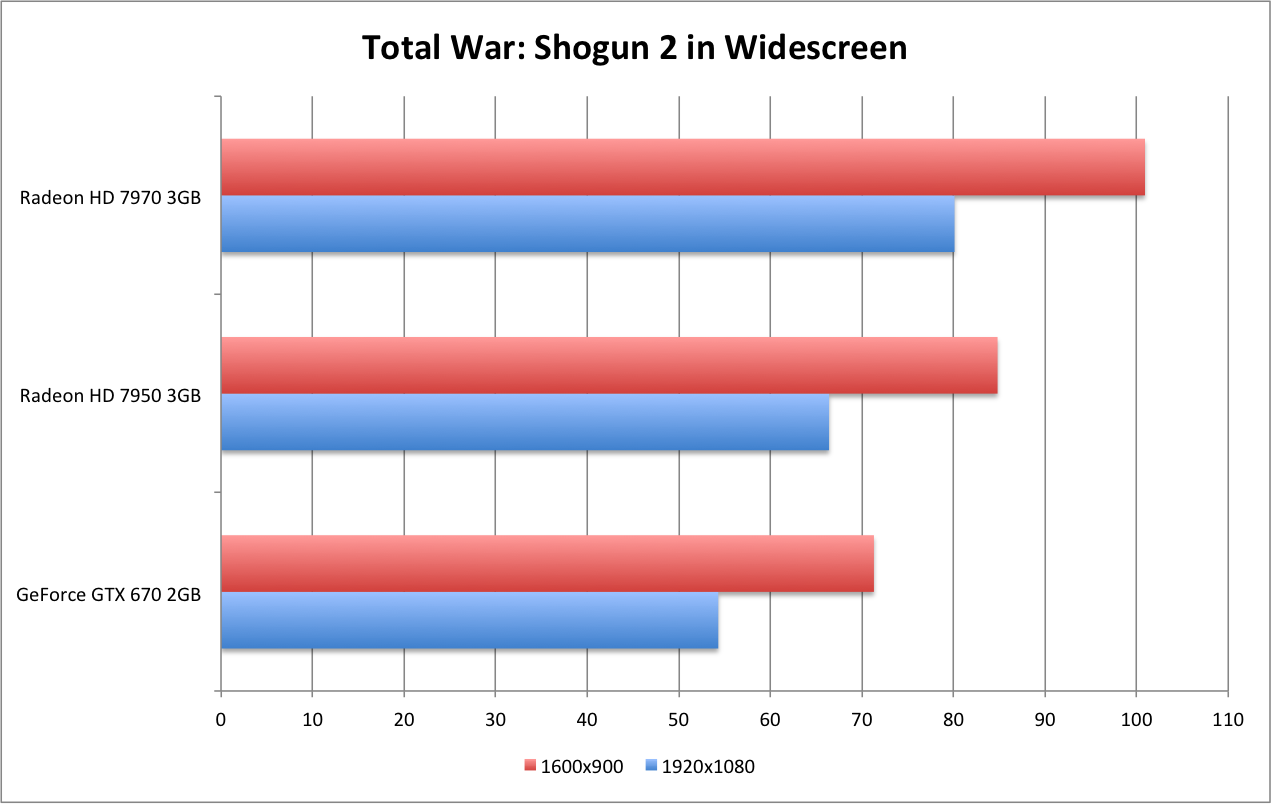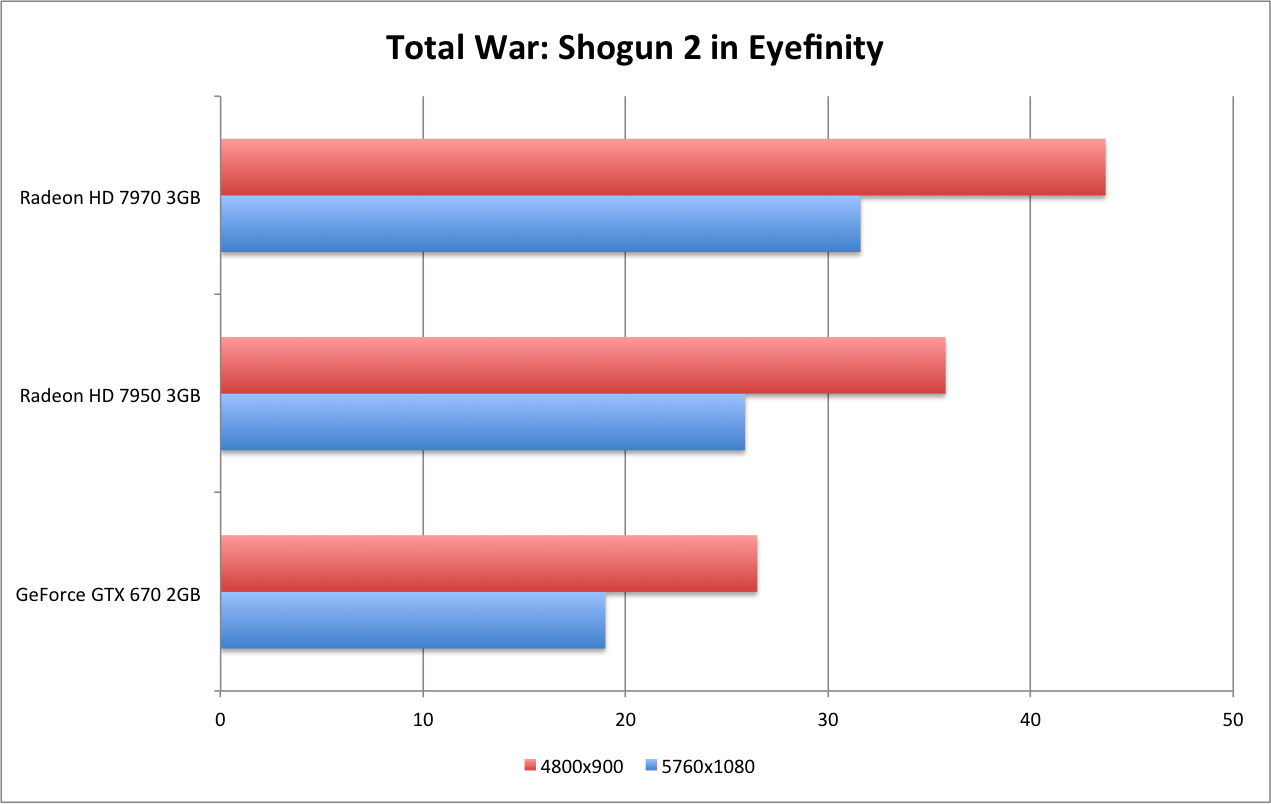NVIDIA GeForce GTX 670 Review - Benchmarking
System Specs
- Windows 7
- ASUS P8Z68-V Pro/Gen3
- Intel i7 2600k at 4x3.4GHz
- 16GB G.Skill DDR3 1.25v low-voltage RAM
- 2x Samsung 320GB T-Series HDD (one for the OS and games; one for swap file and FRAPS)
- LG Super Multi Blu (HD-DVD/Blu-Ray Player)
- Onboard audio
- Corsair HX1000
- My Open PC Dragon Case
- Logitch K340 Keyboard & Performance MX Mouse
- Ergotech Heavy Duty Triple Desk Stand - WSGF Edition
- 3x Dell U2211H IPS 16:9 1920x1080 Displays
Hardware Tested
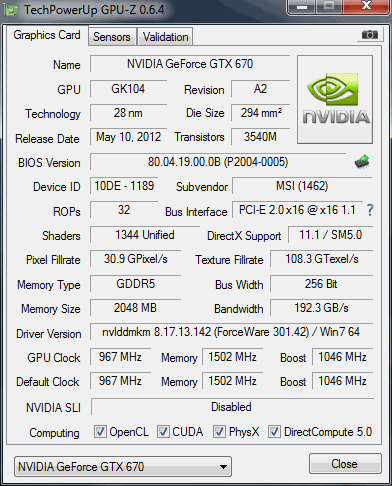
The NVIDIA card tested was the MSI GeForce GTX 670 model N670GTX-PM2D2GD5/OC. It was tested with the GeForce 301.42 drivers. The AMD Radeon HD 7970 and HD 7950 reference boards were tested with the release drivers for the Radeon HD 7970 GHz Edition.
Resolutions Tested
I tested both 1600x900 and 1920x1080 in widescreen, as well as 4800x900 and 5760x1080 in 3x1-L Eyefinity.
Games Tested
I have overhauled my suite of games. I replaced some older titles with their sequels, and I've simply dropped some titles either due to age or the time needed to benchmark. Additionally, I've dropped the DX9 and DX10 tests from the Heaven demo.
- Aliens vs. Predators
- DiRT 3
- H.A.W.X. 2
- Heaven v2.5 DX11
- Mafia II
- Metro 2033
- Total War: Shogun 2
As always, all games are tested at max settings (unless otherwise noted), with 4xAA and 16xAF enabled.
Future Testing
Hopefully we'll be getting our hands on some additional NVIDIA cards in the very near future.
NVIDIA GeForce GTX 670 Review - Aliens vs. Predator
Though it's closing in on two years old, the AvP stand-alone benchmark tool is still a good test of DX11 hardware. It isn't very demanding from a CPU perspective, so it gives a good test of the GPU itself.
The AvP demo also makes good usage of DX11 effects such as Advanced Shadows and Geometry Tessellation, particularly on the alien creature and the alien "pods". There are also some unique lighting effects created with a mobile lighting sources in a floor lamp that is battered around by the alien creatures as they clamor down a tight hallway.
In widescreen, the GTX 670 bests the Radeon HD 7950 by a few frames. Conversely in multi-monitor the Radeon HD 7950 bests the NVIDIA GTX 670 by a few frames.
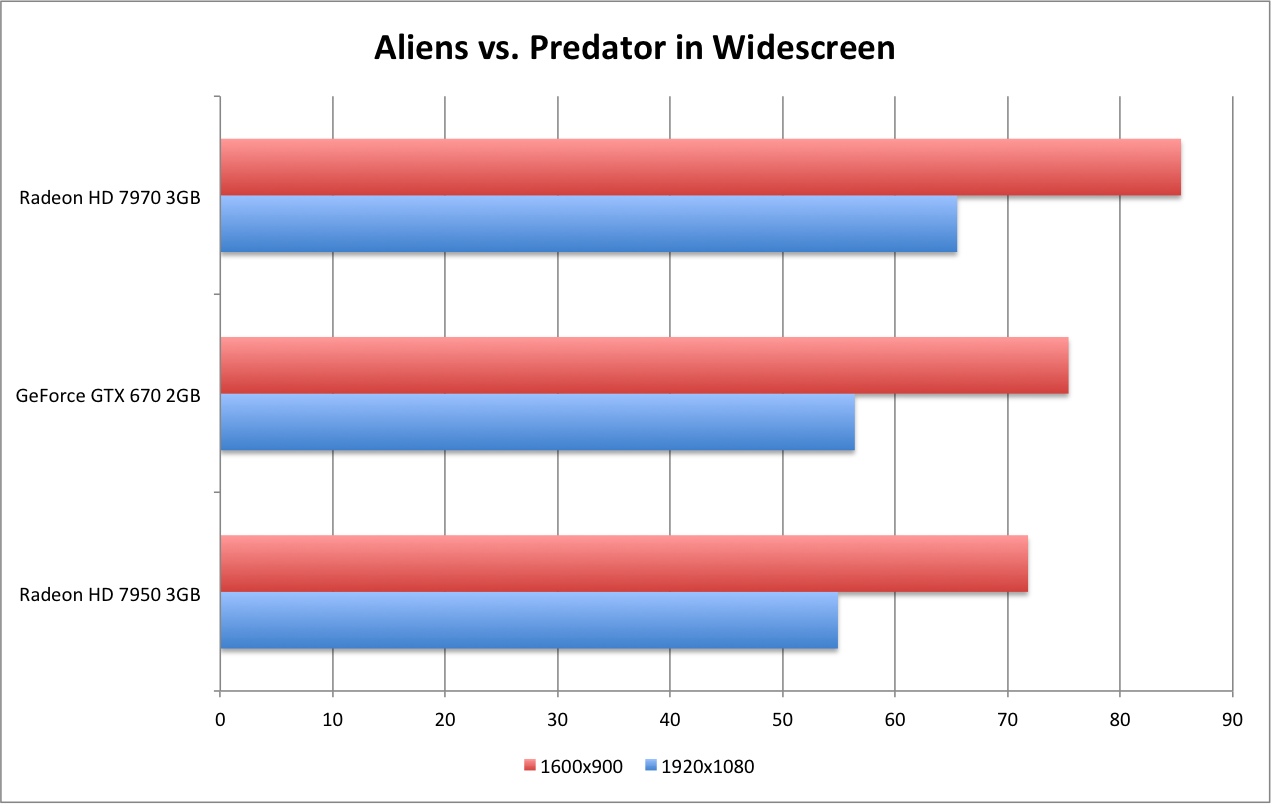

NVIDIA GeForce GTX 670 Review - DiRT 3
Dirt 3 has replaced our previous benchmark of Dirt 2. The Dirt 2 benchmark was the "urban" London circuit, which had several nice examples of water tessellation by way of the car driving through large puddles on the course. The Dirt 3 benchmark we use is the Aspen track, which is a long winding snow course.
Rather than water and cloth effects in Drt 2, the Dirt 3 course showcases snow covered trees that flank a snow-covered course. Tessellation effects are showcased by the tire tracks gouged into the snow. Additionally, there are continuous snow particles kicked up from the cars, and a better chance to see cars flipping and skidding. Overall, a nice and "pretty" update to our Dirt 2 benchmark.
The GTX670 bests even the Radeon HD 7970 in Dirt3, in both widescreen and multi-monitor. In single screen it bests the top-end AMD card by almost 20fps. in 1600x900 it almost hits 120fps, which should appeal to owners of 120Hz panels. With a bit of tweaking the GTX 670 should be able to hit a constant 120fps. The GTX 670 beats the Radeon HD in multi-monitor as well, with a margin of about 5fps. It approaches 60fps at 1600x900 on Ultra settings. A few tweaks should give a constant 60fps.
This is a title where the Adaptive VSync and GPU Boost will help create a great experience, particularly on a single 120Hz monitor.

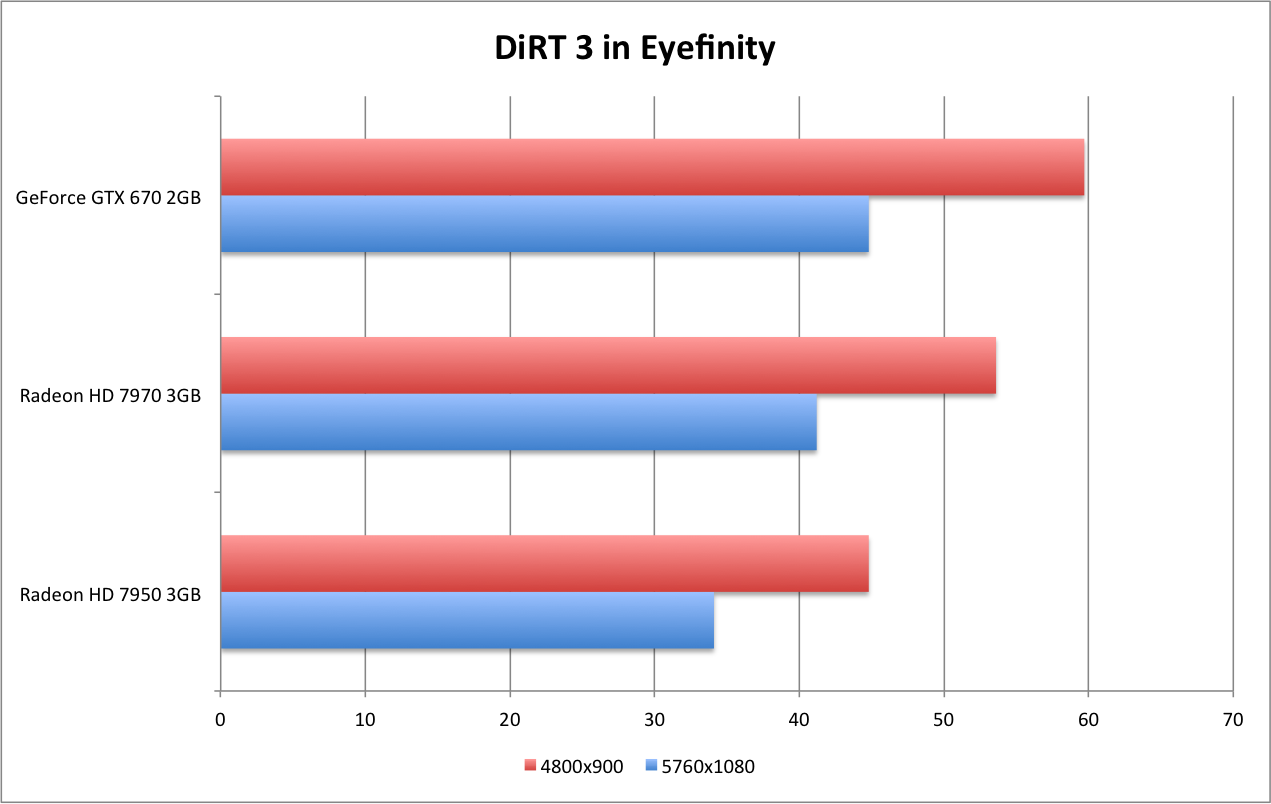
NVIDIA GeForce GTX 670 Review - H.A.W.X. 2
The sequel to the original HAWX updates the original by moving from DX10 to DX11, and utilizing tessellation on the mountainous landscape. The original HAWX demo provided a simple camera fly-through of an area populated by detailed cities and waterways. The "action" consisted mostly of ground explosions and some aircraft engagement.
The HAWX 2 demo removes the cities and water, and focuses on very detailed snow-covered mountain range with a large fleet of aircraft firing missiles. The viewpoint of the camera alternates between a third-person view over the top of a jet, as well as a first-person view inside the same craft.
The GTX 670 handily beats both Radeon cards, in both single and multi-monitor. For single screen, the GTX 670 tops the Radeon HD 7950 by about 30fps, and wins multi-monitor by about 10fps. While these wins are impressive, the reality is that all of the cards push past 120fps in single screen and 60fps in multi. Again, not to take away from the NVIDIA win, but it's simply overkill. One of the more mainstream cards from NVIDIA would still provide a great experience in HAWX 2.
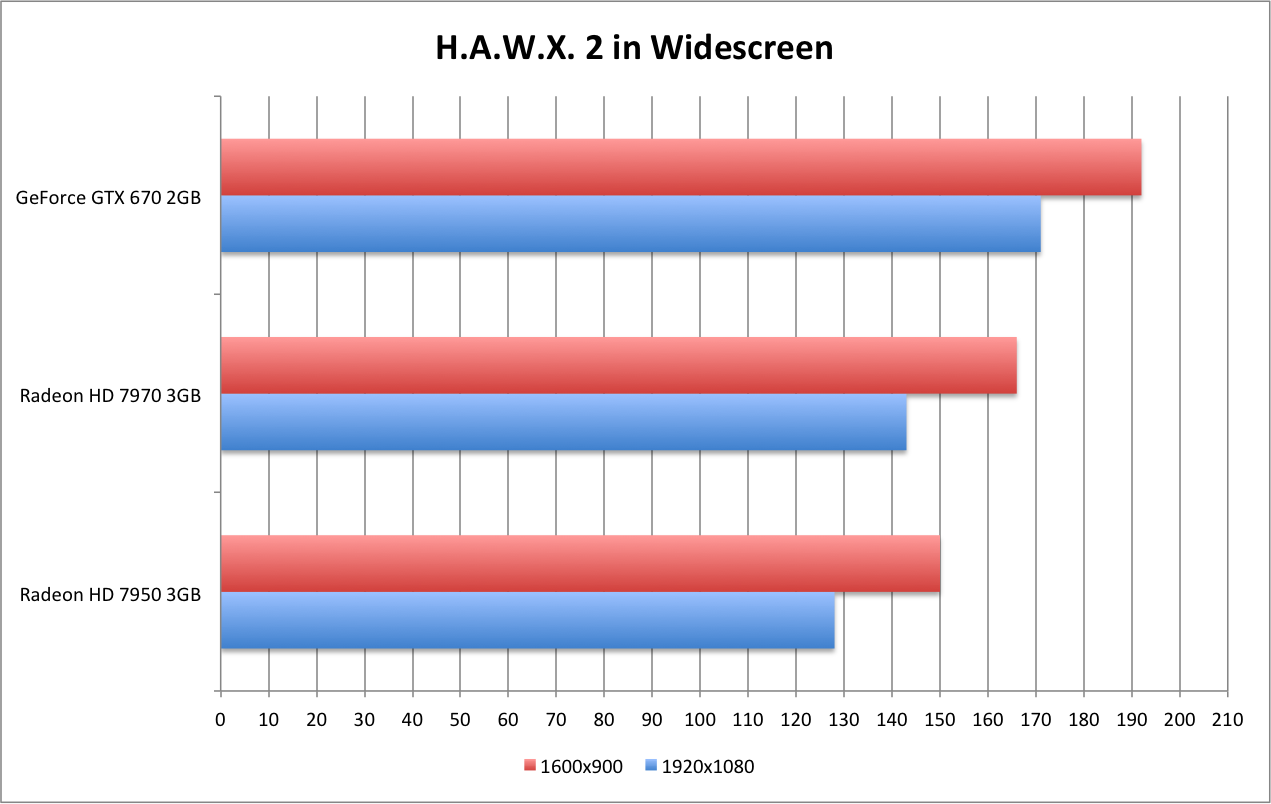
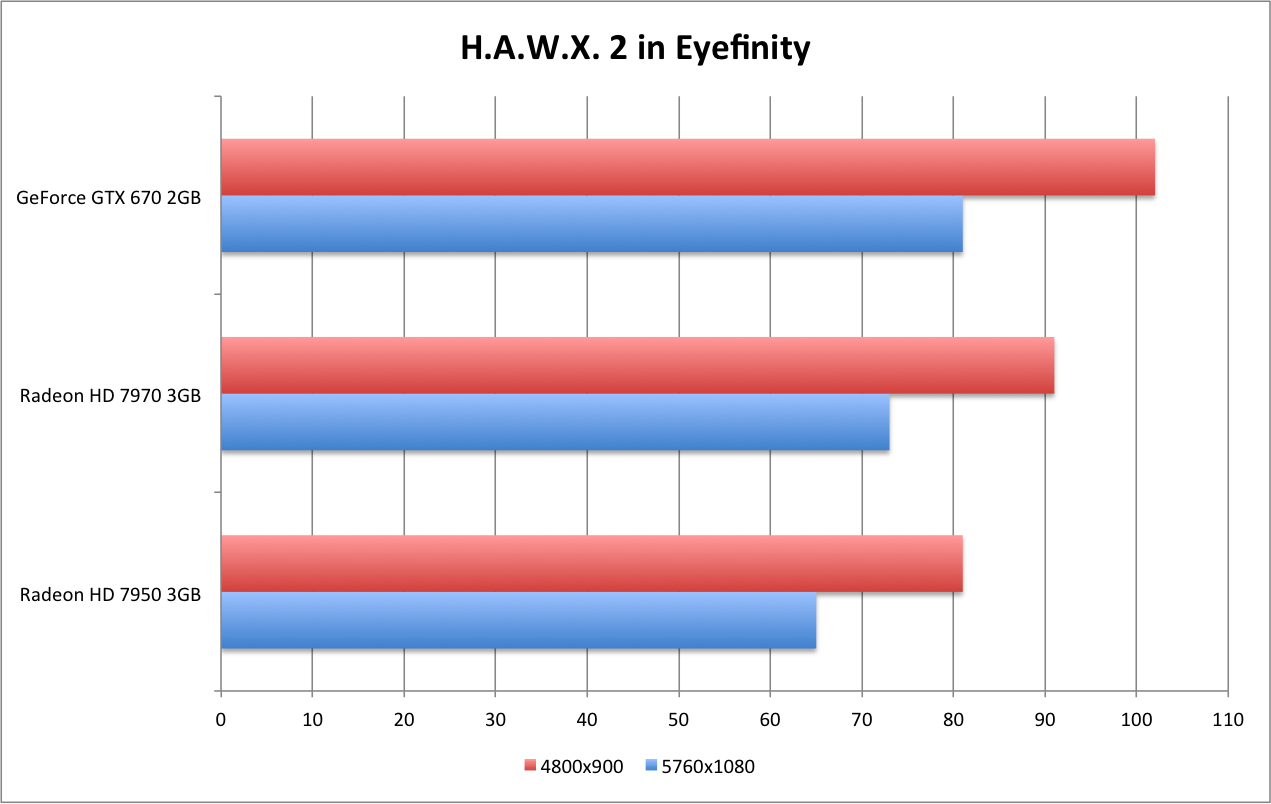
NVIDIA GeForce GTX 670 Review - Heaven v2.5 DX11
Update to the Heaven v2 demo, that has been an long-standing benchmark for many people. Though it's largely the same as the v2 demo, it does add a couple of new set pieces - particularly a new airship. This title is more demanding than the previous iteration, and adds a new tessellation options.
The Heaven demo continues to offer options for testing in DX9, DX10 and DX11 code paths. We have narrowed our testing to DX11, and are no longer testing the DX9 and DX10 code paths. The DX9 and DX10 were more CPU dependent and less of a test of the strength or weakness of the GPU. The DX11 truly stresses a GPU.
The GTX 670 bests the Radeon HD 7970 by 10fps at 1600x900, and 5fps at 1920x1080. In multi-monitor the GTX 670 slots in between the Radeon HD 7950 and the HD 7970.
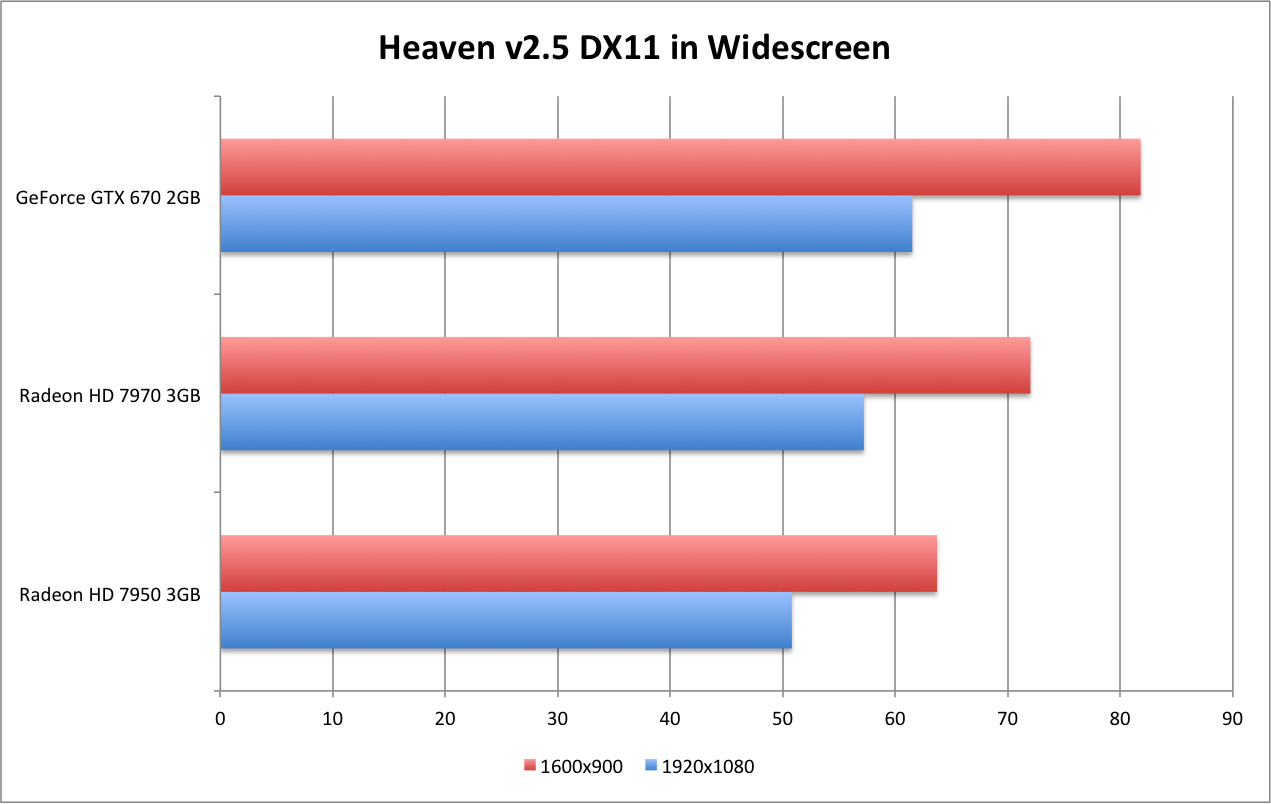
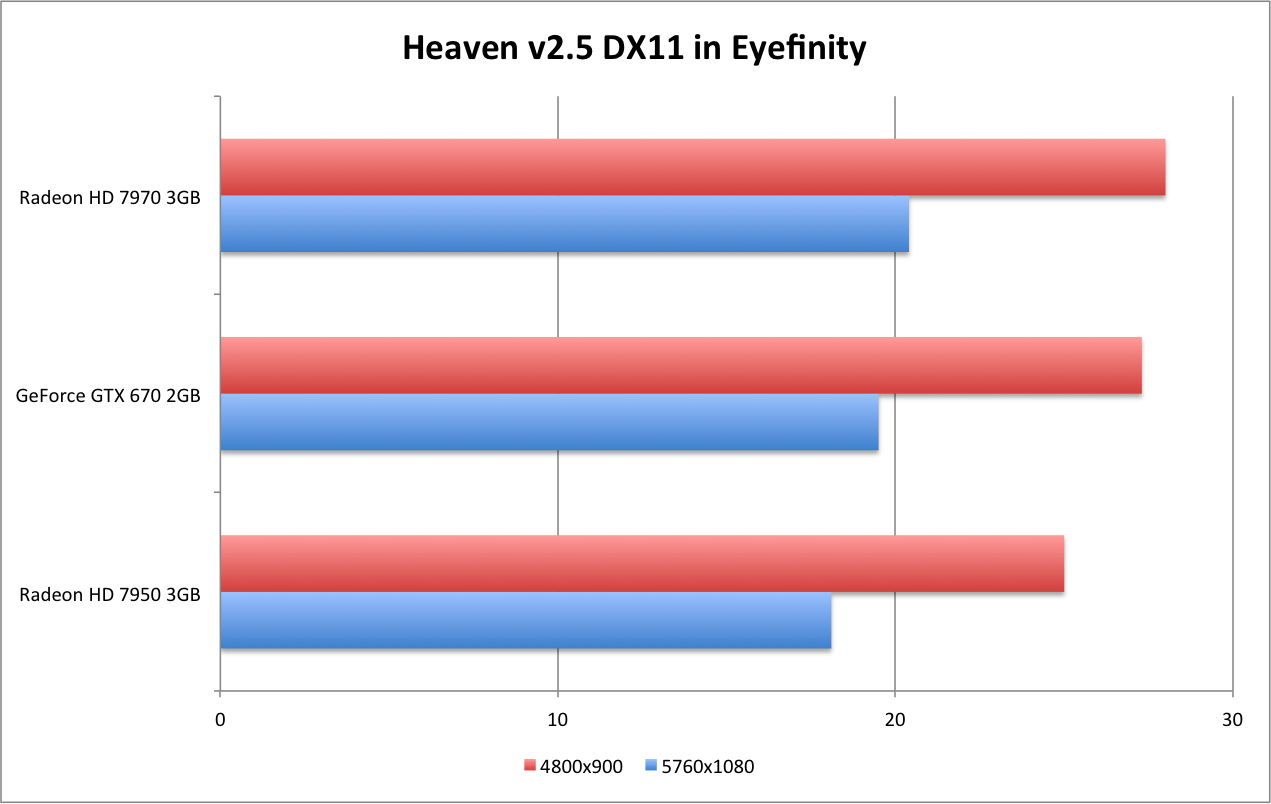
NVIDIA GeForce GTX 670 Review - Mafia II
Demanding benchmark that is included with the Mafia II open-world crime title. The title begins with an exterior gunfight, highlighting cars losing parts and being destroyed. The demo then moves inside a warehouse which highlights a gun battle, with destructible environments (brick columns) and excellent flame effects.
One thing to note is that the demo performs much better on a second run-through. The first run shows noticeable hiccups during the loading of different scenes. Subsequent runs run much smoother, though the overall average isn't seriously effected. The title does support PhysX, though we've tested with it turned off, to ensure a consistent comparison.
The GTX 670 really blows away the AMD products in the Mafia II demo. I reran the test several times, as I couldn't believe the difference in performance. In the end the settings were the same and the numbers were accurate. The title is an NVIDIA "The Way It's Meant to Be Played" title and is obviously optimized for the NVIDIA hardware.

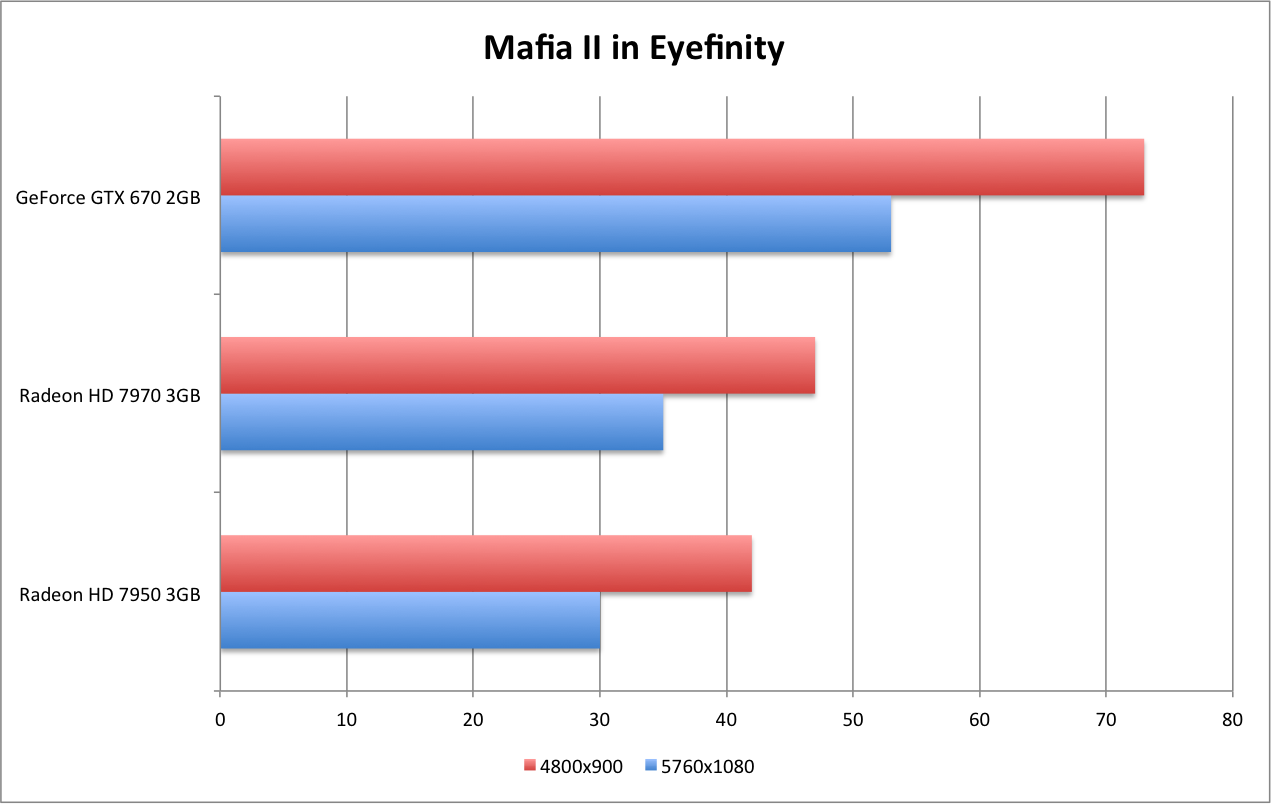
NVIDIA GeForce GTX 670 Review - Metro 2033
Demanding benchmark that is included in the popular FPS, Metro 2033. The demo is a camera fly through in a subway tunnel. There are large amounts of gunfire, cloth and lighting effects. The demo has a number of noticeable slowdowns from heavy flame, fog and motion blur effects. We run the game on the DX11 code path.
The GTX 670 slots directly between the two Radeon cards, in both widescreen and multi-screen. It bests the HD 7950 by a few frames, and is in turn beaten by the 7970 by a few frames.
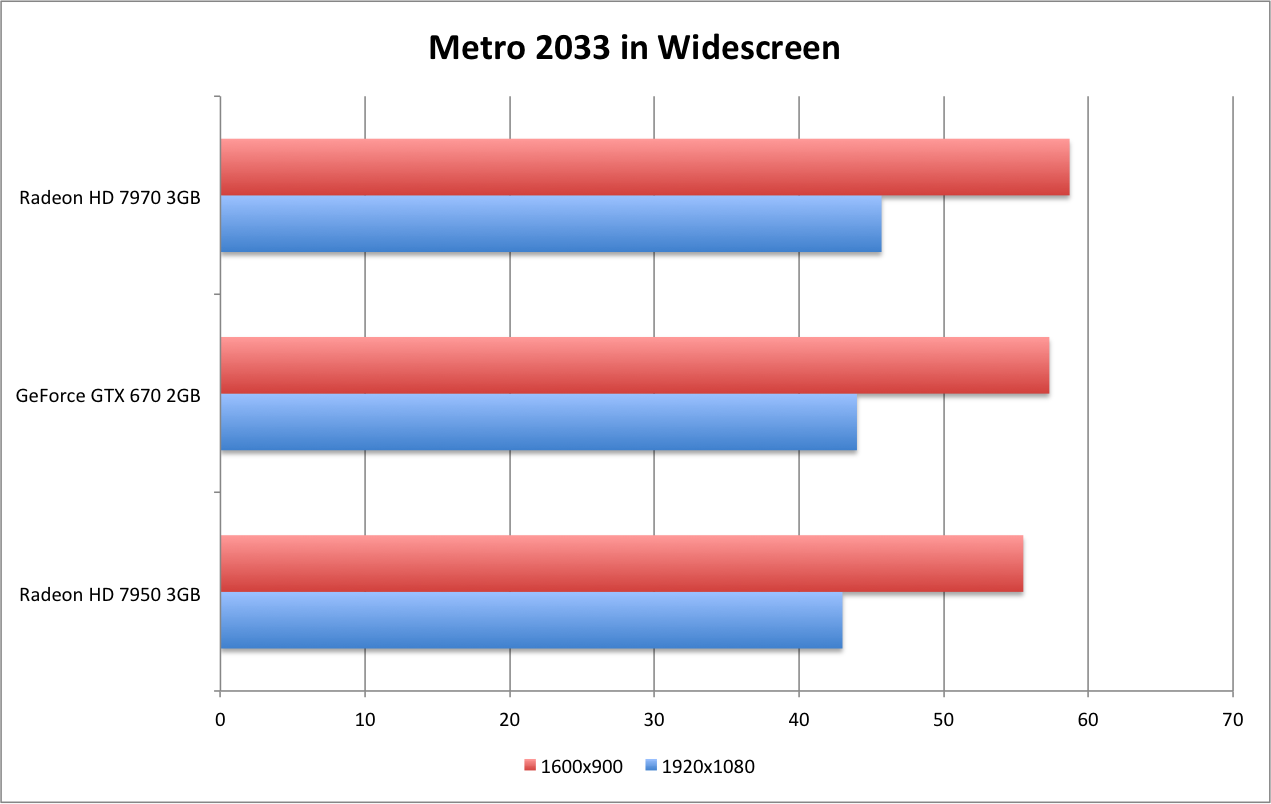
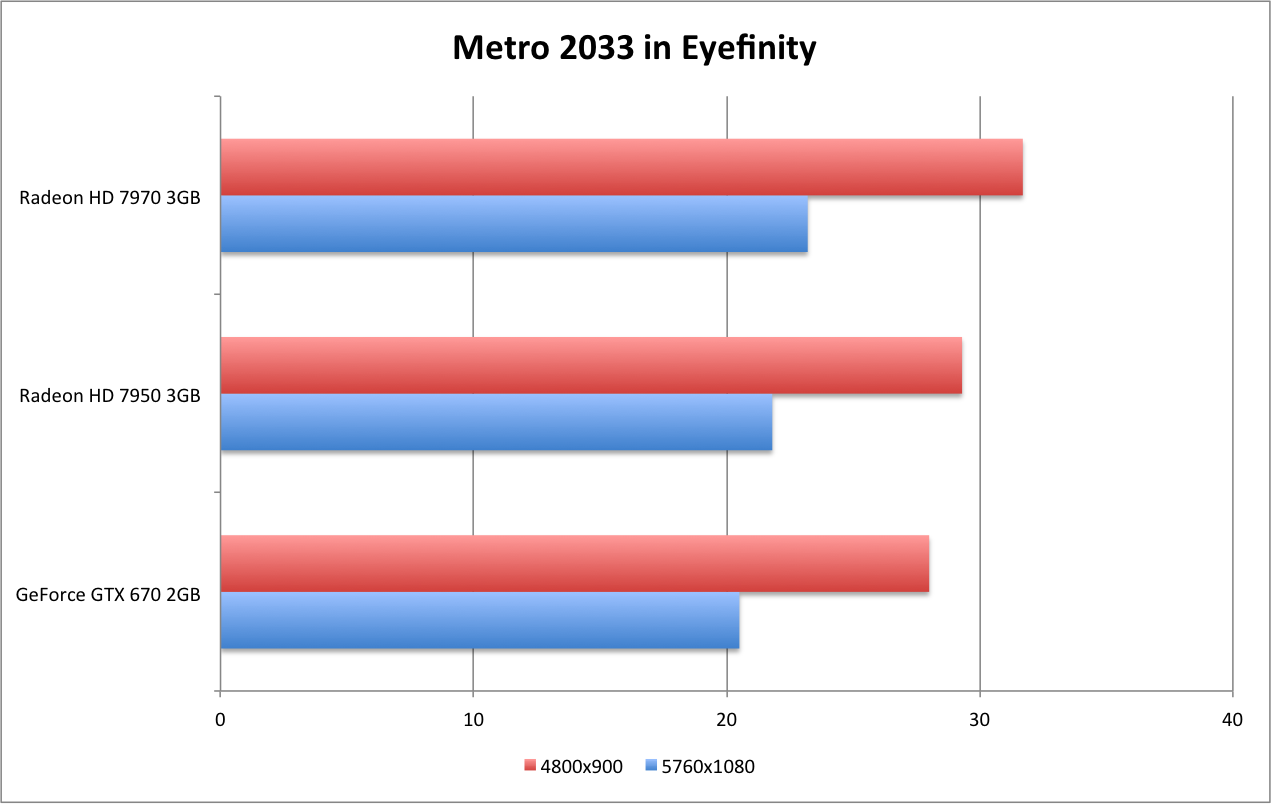
NVIDIA GeForce GTX 670 Review - Total War: Shogun 2
This benchmark is included with Total War: Shogun 2. This is the one instance we are not running at full "max" settings with 4xAA/16xAF. The benchmark simply will not run at these settings in Eyefinity on any 1GB card. To enable a consistent benchmark across all cards I've used these settings: "Very High" preset, 2xAA, and all the DX11 options turned on.
The title showcases a number of scenes - both broad views of large scale battles (with large numbers of units), and highlighting the detail in marching columns of soldiers.
This is the one title where the AMD cards are clear winners. The Radeon HD 7950 beats the GTX 670 by more than 10fps in widescreen, and almost 10fps in multi-monitor. Based on our experience with running this benchmark on a range of AMD video cards, we've found that RAM is a major limiting factor in performance and even in allowing the benchmark to run. I believe the extra RAM on the Radeon cards is helping performance here. Additionally Shogun 2 is an AMD "Gaming Evolved" title and has been optimized for their hardware.
